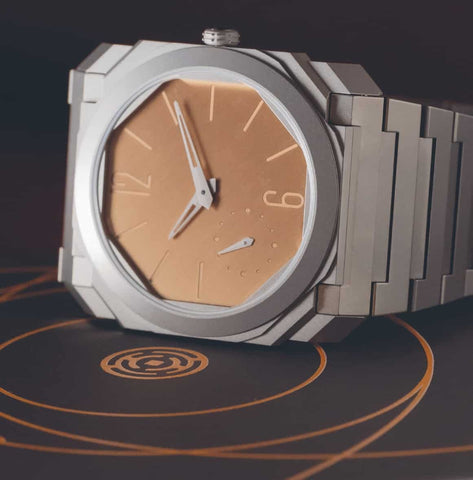Design is an essential element in determining the character of a watch. Fabrizio Buonamassa Stigliani, Creative Director of Bulgari, the hand behind the success of the Roman maison's creations, knows this well. Let's retrace with him his history and the genesis of the Octo Finissimo for Pisa Orologeria.

I was born with a pencil in my hand. I never thought about doing anything else. Beyond knowing how to draw, the main challenge of a designer is being able to imagine objects that don't exist and being able to draw anything, compatible with the studies he has done. He's not an engineer, he's not an architect. But he must be able to imagine a product in its entirety, be it a chair, a telephone, a pen, a watch or a car. As for watches, I've always liked them. And to draw them you need a great passion. Unlike a sector like the automotive one, which today has such an important social impact that it has led to the creation of automotive design schools all over the world, there are proportionately few people who study to become watch designers. It's a very different world, definitely smaller. Not only in the dimension of objects but also in that of companies.
WHAT ARE YOUR CULTURAL POINTS OF REFERENCE, YOUR SOURCES OF INSPIRATION, THE STORIES AND CHARACTERS THAT YOU THINK HAVE DEFINED YOUR STYLE?
Industrial Design remains one of my points of reference. As we know it today, Industrial Design was born with the industrial revolution and was essentially a discipline created to "dress up" the products made by industry. Over the years, Italians have managed to develop this discipline by combining it with Aesthetics and elevating it to an art form.
In addition to the innate sense of proportions and taste for beauty, Italian designers have also been able to innovate, creating new types of products and "educating" consumers to use them in a different way, in this way they have given objects a second life as in the case of the Tubogas bracelet by Bulgari which was an object inspired by an everyday object. As Achille Castiglioni says, "objects must keep us company" and, I would add, even more so the objects that accompany us for a lifetime, also representing unique moments.
Innovation, a sense of proportion and the use of the constraint as a typological and aesthetic element around which the entire project revolves have always represented the typical elements of Italian Design.
Bulgari is fully part of this tradition through the use of unique proportions, often unusual materials as happened in the past with porcelain for the Chandra jewelry collection, aluminum and rubber in the Aluminum watch and the use of steel in jewelry. All this is part of the tradition and DNA of the brand and it is my job to evolve these concepts while respecting the typical elements of the brand.
WHAT IS YOUR CREATIVE PROCESS? DO YOU FOLLOW A FIXED SCHEME OR DO YOU TACKLE EACH PROJECT IN A DIFFERENT WAY?
The fundamental aspect when designing a product is to understand the design and aesthetic language that represents it, the way of use, the materials and the history that it brings with it, in short the "Project Culture", once this has been understood you can draw cars, watches, jewelry or anything else.
Naturally the target audience is very important when thinking about a product and should always be kept in mind as the main reference.
As for inspiration, it can be found everywhere. Clearly the city of Rome – with its architecture, its monuments and its special light – represents a great source of inspiration for me. The proportions found in Roman architecture embody a magnificence that we often try to transfer and convey in our products.
Often the inspiration comes from the brand itself: the history of Bulgari is so rich in ideas that it represents an inspiration in itself.
It is interesting for a designer to work in a brand with such an important history behind it: sometimes it places constraints on you, but the constraints also represent the most significant challenge.

WHAT IS YOUR CREATIVE PROCESS? DO YOU FOLLOW A FIXED SCHEME OR DO YOU TACKLE EACH PROJECT IN A DIFFERENT WAY?
The fundamental aspect when designing a product is to understand the design and aesthetic language that represents it, the way of use, the materials and the history that it brings with it, in short the "Project Culture", once this has been understood you can draw cars, watches, jewelry or anything else.Naturally the target audience is very important when thinking about a product and should always be kept in mind as the main reference.
As for inspiration, it can be found everywhere. Clearly the city of Rome – with its architecture, its monuments and its special light – represents a great source of inspiration for me. The proportions found in Roman architecture embody a magnificence that we often try to transfer and convey in our products.
Often the inspiration comes from the brand itself: the history of Bulgari is so rich in ideas that it represents an inspiration in itself.
It is interesting for a designer to work in a brand with such an important history behind it: sometimes it places constraints on you, but the constraints also represent the most significant challenge.
DO YOU WORK WITH PAPER AND PENCIL, OLD STYLE, OR DIGITALLY?
I work mainly with pen and paper. I have a real passion for pens, I have lots of them, fountain pens and ballpoint pens. Everywhere: in the office, in my jacket, at home. The one I choose to use from time to time depends on the type of sketch I need to create. If it is a sketch, the study of some ideas, I use a ballpoint pen. For precision drawing, I prefer one of my fountain pens. Sometimes I also use digital technologies but pen and paper remain my passion.
WHAT ARE THE CHALLENGES IN DESIGNING A WATCH?
Each product or collection has its own particularities but a creative in my position continually thinks about the products he has to design, trying to innovate the typical signs of the brand and creating products that do not yet exist today. Understanding customers' hidden needs and wants by trying to imagine how they will use the products we are designing now. Ettore Sottsass maintained that for a designer one of the most complicated things is understanding who will use his product: after so many years this remains one of the most important questions.TECHNIQUE AND AESTHETICS: THE WATCH INCLUDES, MORE THAN OTHER OBJECTS, THESE TWO ELEMENTS. HOW MUCH DOES ONE INFLUENCE THE OTHER AND HOW?
Like Italian design, Bulgari design is characterized precisely by an approach to functionality in which it is not the form that simply follows the function: it is the constraint that generates an aesthetic. In the Octo Finissimo Minute Repeater we had the creative idea of having a titanium dial open with numerous engravings corresponding to the indexes and the small seconds counter which responded to a certain aesthetic but which were also functional at the same time, in order to allow the sound to propagate as best as possible and make the most of all 6.85 millimeters of the case. The result is surprising. Choices that have contributed to giving the timepiece an appearance that is not only highly contemporary but also apparently normal, almost as if it were a "common" only time. Expression of a hidden luxury that can also be worn every day, in everyday life.

BULGARI IS A BRAND WITH A LONG HISTORY AND CONSOLIDATED AESTHETIC CANONS. HOW TO FIND THE BALANCE BETWEEN THE CHARACTER OF A BRAND AND THE PERSONALITY OF THE DESIGNER?
In my daily work I feel free, because with experience I can perceive the aesthetics of the company, I know its history and signs. I am the type of designer who builds the object together with his team. I'm in the office, discussing with my collaborators the evolution of one product rather than another.
I try to stimulate them on issues that are close to the brand from a formal, aesthetic and product typology point of view. A company like Bulgari, with various types of products, must have a well-defined aesthetic and stylistic identity. But in general, I have no stylistic guidelines. Now in my head I think of Bulgari products, I have the aesthetic criteria of the brand and I am aligned with my taste. A designer must possess the aesthetic sensitivity that his company needs.

WHAT IS THE GENESIS OF THE OCTO FINISSIMO COLLECTION AND WHAT CHALLENGES DID YOU HAVE TO FACE?
The challenge was first of all to create an Octo that was 5 millimeters thick and then a movement that was 1.95 millimeters thick in the case of the tourbillon, 2.23 in the case of the small seconds.
It is a type of approach towards an object that I define as almost "military" or Formula One, because they are two worlds in which decoration has no place: there must only be what must work, perfectly.
A function that surpasses all aesthetic concepts and, since Octo has faceted, applied indexes even if very thin.

